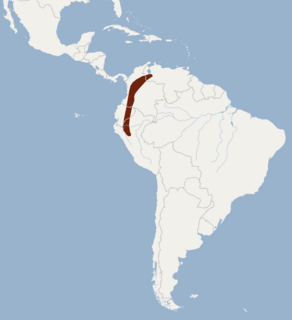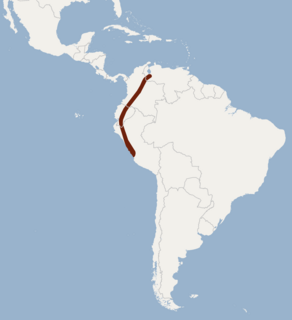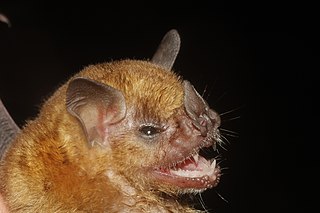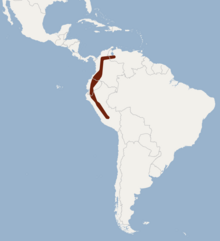
The New World leaf-nosed bats (Phyllostomidae) are found from southern North America to South America, specifically from the Southwest United States to northern Argentina. They are ecologically the most varied and diverse family within the order Chiroptera. Most species are insectivorous, but the phyllostomid bats include within their number true predatory species and frugivores. For example, the spectral bat, the largest bat in the Americas, eats vertebrate prey, including small, dove-sized birds. Members of this family have evolved to use food groups such as fruit, nectar, pollen, insects, frogs, other bats, and small vertebrates, and in the case of the vampire bats, even blood.

The Colombian bonneted bat, also known as Trumbull's bonneted bat, is a bat species found in Bolivia, Brazil, Colombia, French Guiana, Guyana, Peru, Suriname and Venezuela.

The big crested mastiff bat, is a bat species from South and Central America.

The bidentate yellow-eared bat is a species of bat in the family Phyllostomidae, native to South America. Formerly classified in the Vampyressa genus, phylogenetic analyses support its inclusion in Vampyriscus.

Allen's yellow bat is a species of vesper bat. There is some taxonomic debate surrounding this species, with some authors considering Baeodon a genus rather than a subgenus. It is endemic to Mexico.

The velvety fruit-eating bat, also known as Hart's little fruit bat, is a species of bat in the family Phyllostomidae. It is the only species within the genus Enchisthenes. It is found in Central America, Mexico, the United States, and northern South America.

Aratathomas's yellow-shouldered bat is a species of bat in the family Phyllostomidae native to South America.

Sturnira known as a yellow-shouldered bat or American epauleted bat, is a genus of bat in the family Phyllostomidae. The genus name comes from the Latin for "starling" and refers to HMS Starling, which took part in an 1836 voyage to Brazil during which the type specimen was collected. It contains the following species:

The Bogotá yellow-shouldered bat is a species of bat in the family Phyllostomidae. It is found in Colombia, Ecuador, Peru, and Venezuela at altitudes from 300 m to above 2000 m, particularly in cloud forest. The species is primarily frugivorous; it may also consume nectar and pollen.

The Talamancan yellow-shouldered bat is a species of bat in the family Phyllostomidae. It is found only in Costa Rica and Panama, and there are no subspecies.

The lesser yellow-shouldered bat is a species of bat in the family Phyllostomidae. It is native to Peru and Ecuador. It is threatened by habitat loss.

Stenodermatinae is a large subfamily of bats in the family Phyllostomidae.

Vampyriscus is a genus of bats in the family Phyllostomidae, the leaf-nosed bats.

Sturnira honurensis is a species of bat found in Central America. Previously, it was considered a subspecies of the highland yellow-shouldered bat, but it has been considered distinct since 2010.
Sturnira perla is a species of yellow-shouldered bat found in Ecuador.
Burton's yellow-shouldered bat is a species of leaf-nosed bat found in Panama and Costa Rica.

The Tasmanian long-eared bat is a species of vesper bat endemic to Tasmania.

Sturnira koopmanhilli is a species of leaf-nosed bat found in South America.

Sturnira bakeri is a species of bat found in South-America.

Sturnira parvidens is a species of leaf-nosed bat found in Central America.


















